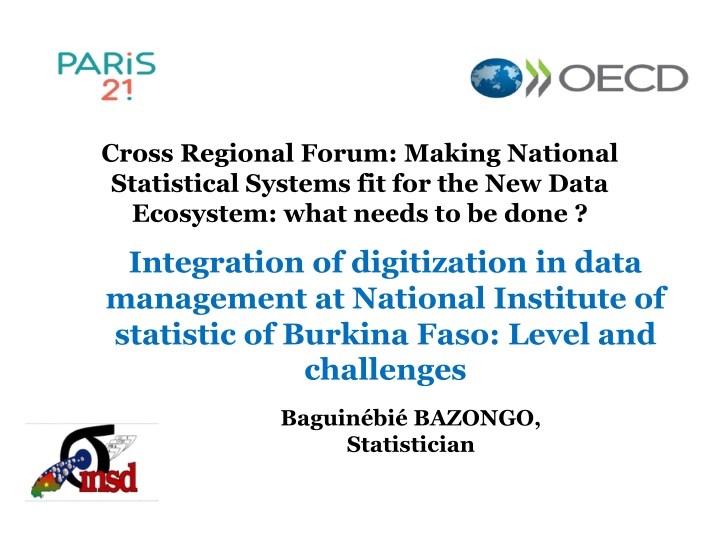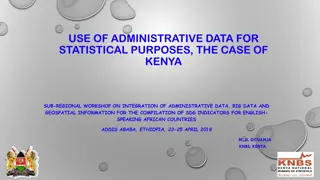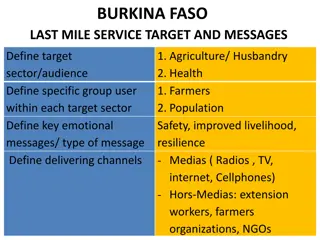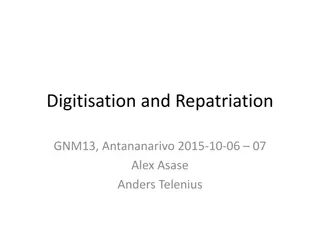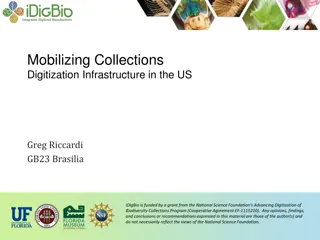Enhancing Data Digitization at National Statistical Systems - A Case Study of Burkina Faso
National Institute of Statistics in Burkina Faso, established in 1974, faces challenges in integrating digitization for data collection and dissemination. With a staff of 257, including 167 statisticians-demographers and 4 IT professionals, the level of digitization is progressing but faces hurdles in data sharing and accessibility. Initiatives like using smartphones for surveys are in place, but further improvements are needed for efficient data management.
Uploaded on Oct 08, 2024 | 3 Views
Download Presentation

Please find below an Image/Link to download the presentation.
The content on the website is provided AS IS for your information and personal use only. It may not be sold, licensed, or shared on other websites without obtaining consent from the author.If you encounter any issues during the download, it is possible that the publisher has removed the file from their server.
You are allowed to download the files provided on this website for personal or commercial use, subject to the condition that they are used lawfully. All files are the property of their respective owners.
The content on the website is provided AS IS for your information and personal use only. It may not be sold, licensed, or shared on other websites without obtaining consent from the author.
E N D
Presentation Transcript
Cross Regional Forum: Making National Statistical Systems fit for the New Data Ecosystem: what needs to be done ? Integration of digitization in data management at National Institute of statistic of Burkina Faso: Level and challenges Baguin bi BAZONGO, Statistician
Content Presentation of national institute of statistic Level of digitization (data collection and dissemination) Implementation of 5thpopulation census Challenges Recommendations
National Institute of statistic (1/2) INSD is created in 1974 Missions Produce official statistic Population census Business surveys Household surveys DHS surveys Disseminate statistical information according to national and international standard Develop and implement capacity building program for NSS Coordinate NSS
National Institute of statistic (2/2) Staff Total of 257 workers; 42 women and 215 men; 167 statisticians-demographers; 4 IT professional Offices Central office and 3 regional offices Production Four population census (1975, 1985, 1996, 2006) More than 10 household surveys on poverty (1994, 1998, .) Four DHS (1993, 1998, 2003, 2010) Four industrial and commercial census
Level of digitization at INSD (1/2) Only 3 household surveys used Smartphone and tablet to collect data in 2018 Labor and informal sector survey in 2018 (9000 households); data collection ended; currently data cleaning Households poverty survey in 2018; data collection in progress (7020) Survey on violence against women in 2018; data collection in progress However, some institutions of NSS such as department of agricultural statistic and population science Institute (ISSP) integrated PDA in data collection since 2015
Level of digitization at INSD (2/2) Two web sites to share documents http:// insd.bf and http://cns.bf/ Public data are shared with devices, not available at INSD web site So, users don t know what kind of data are available; need to access physically INSD to look for data Even if data are available, users often experience issues to compute some indicators (sub-level)
Implementation of 5thpopulation census (1/2) 5thpopulation census data collection is planed to be done in December 2016 Data will be collected using Smartphone and Csentry application (21 000 Smartphone needed) as recommend by UN Cost of implementation increases from 12.2 millions in 2006 to 30 millions EURO in 2016 ( 125% because of investment in IT) Because of lack of money, census is rescheduled for 2017, than 2018
Implementation of 5thpopulation census (2/2) Currently, 22 000 Smartphones available, Servers and other IT equipments installed, interviewers recruited for pilot Cartography is done with paper, no outline coordinates; 26,000 Enumeration Areas Gap of 4,000 Smartphones, 4,000 interviewers, implies additional cost of 2 millions EURO IT and statisticians build their first Data Entry application for data collection
Challenges (1/2) Needs of digitization are expressed by partners (World Bank, UNFPA, European Union, WAEMU), not by NSS leaders Some NSS leaders don t trust technology; not sure digitization works better than traditional methods Digitization need more investment, but lot of priorities in the country Lack of technical skills to design useful application for data collection and data dissemination Complex procurements procedures (at least 3 months)
Challenges (2/2) Low internet coverage (urban areas) Low coverage of electric power (urban areas) High level of insecurity (terrorism, robbery) Lack of places to store IT material Low IT skills of interviewers
Recommendations Train NSS staff who collect and analyze data in IT, particularly application design Build a dashboard online to increase data access by users (be able to compute indicators without access micro data) Increase internet and electric power coverage
Thank you for your attention bazongo15@yahoo.fr
